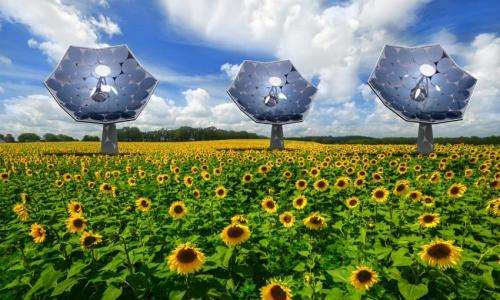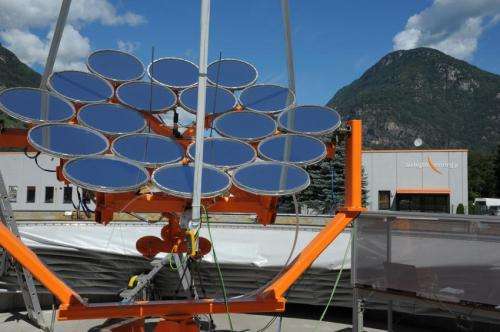October 7, 2014 weblog
IBM Research, Airlight Energy work on affordable solar tech

A system that can concentrate the sun's radiation by 2,000 times and convert 80 percent of it into useful energy has been developed by IBM Research in a team effort with Airlight Energy of Switzerland.
Engineers at IBM Research and Airlight Energy are announcing the technology, which is able to generate 12 kW of electrical power and 20 kW of heat on a sunny day, enough to power several average homes. Hot-water cooling technology is involved in this solution. Dr. Gianluca Ambrosetti of Airlight Energy said that the system that his group is developing jointly with IBM Research provides electricity "and very efficiently so," and more. Airlight Energy is a Switzerland-based supplier of technology for the large-scale production of electricity using solar power and for energy storage. He is responsible for the development of the high-concentration solar photovoltaic system (HCPVT) currently being developed with IBM Research. "Imagine," he wrote in a TED Blog, "a world where, no matter how far you live from an electricity grid or a pump station, you will have access to clean power, heating, refrigeration, drinkable water and even gasoline. Now, imagine that this technology can do it using everyday materials like concrete, reflective aluminum foil and air—plus the ultra-high-efficiency solar cells used in satellites." Ambrosetti heads research at the company, which seeks to bring solar energy to remote parts of the planet using sunflower-shaped panels. The system sits on an advanced sun tracking system, which positions the dish at the best angle throughout the day to capture the rays.
The HCPVT system looks like a 10-meter-high sunflower, and it uses a 40 square meter parabolic dish. This dish is made of patented fiber-based concrete. Ambrosetti talked about the use of concrete for the structure, and noted that the concrete has "interesting properties" and is also inexpensive. IBM said that the concrete can be molded into nearly any shape in less than four hours and has mechanical characteristics similar to those of aluminum, at one-fifth the cost.

The inside of the parabolic dish is covered with 36 elliptic mirrors made from recyclable foil with a silver coating, said the video about the project. The mirrored surface area concentrates the sun's radiation by reflecting it onto several microchannel liquid-cooled receivers, each of which is populated with a dense array of multi-junction photovoltaic chips. The mirrors and receiver are encased with a large inflated transparent plastic enclosure to protect them from rain or dust. The enclosure also prevents birds and other animals from getting in harm's way.
(In a case study report, IBM noted that a key technical challenge was cooling the photovoltaic cells, which without cooling would heat up to 2,000 degrees Celsius and be destroyed within seconds. "To perfect the system, Airlight Energy scientists sought a technology to cool the cells while recycling the waste heat to perform useful work." They found the solution working with IBM Research–Zurich.)
The photovoltaic chips are mounted on micro-structured layers that pipe treated water within fractions of millimeters of the chip to absorb the heat and draw it away 10 times more effectively than with passive air cooling, said IBM.
The goal, said IBM, is to bring affordable solar technology to the market by 2017. "With the HCPVT we are ushering in a new generation of solar energy technology," said Ambrosetti. "Not only is the system affordable, but it will create jobs where it is installed because many of the materials will be sourced locally. We expect to partner with firms around the world to bring a commercial version to market by 2017."
What is the life of the system? The operating lifetime for the HCPVT structure, with proper maintenance, according to IBM, is up to 60 years. The plastic elliptic mirrors and protective foil would need to be replaced every 10 to 15 years, while the photovoltaic cells would need replacing every 25 years, said IBM.
More information:
www.zurich.ibm.com/news/14/dsolar.html
public.dhe.ibm.com/common/ssi/ … sen/RSC12348USEN.PDF
© 2014 Tech Xplore

















